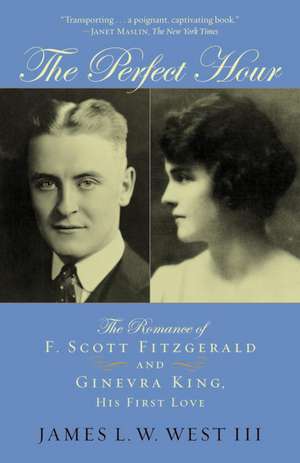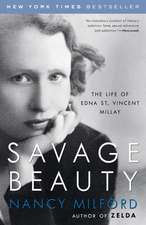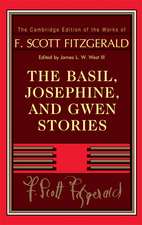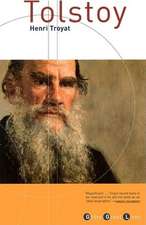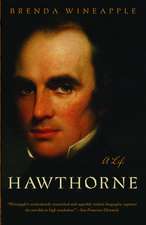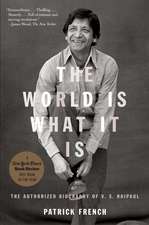The Perfect Hour: The Romance of F. Scott Fitzgerald and Ginevra King, His First Love
Autor James L. W. West IIIen Limba Engleză Paperback – 31 ian 2006
For Scott and Ginevra, “the perfect hour” was private code for a fleeting time they almost shared and then yearned after for the rest of their lives. Now West brings that perfect hour back to life in all its freshness, delicacy, and poignant brevity.
Preț: 109.00 lei
Nou
Puncte Express: 164
Preț estimativ în valută:
20.86€ • 22.65$ • 17.52£
20.86€ • 22.65$ • 17.52£
Carte disponibilă
Livrare economică 01-15 aprilie
Preluare comenzi: 021 569.72.76
Specificații
ISBN-13: 9780812973273
ISBN-10: 0812973275
Pagini: 211
Ilustrații: 15 PHOTOS THROUGHOUT
Dimensiuni: 134 x 205 x 13 mm
Greutate: 0.17 kg
Editura: Random House Trade
ISBN-10: 0812973275
Pagini: 211
Ilustrații: 15 PHOTOS THROUGHOUT
Dimensiuni: 134 x 205 x 13 mm
Greutate: 0.17 kg
Editura: Random House Trade
Notă biografică
JAMES L.W. WEST III is Sparks Professor of English at Pennsylvania State University. He has held fellowships from the Guggenheim Foundation, the National Humanities Center, and the National Endowment for the Humanities, and has been a Fulbright scholar to England and Belgium. He is the author of William Styron: A Life and is general editor of the Cambridge Edition of the Works of F. Scott Fitzgerald.
From the Hardcover edition.
From the Hardcover edition.
Extras
Chapter 1
Ginevra and Scott
Ginevra King was the eldest of the three daughters of Charles Garfield King, a wealthy Chicago stockbroker, and Ginevra Fuller King, his wife. There was money on both sides of the family, earned by Ginevra’s grandfathers, both of whom were self-made men. Her paternal grandfather, Charles Bohan King, had come to Chicago from upstate New York in 1863. At first he worked as a wholesale grocer, then as a jobber in hats, caps, and furs. He eventually moved into banking and prospered, retiring in 1885 as president of the Commercial Safe Deposit Co. He was a Republican and a Presbyterian; he sent his older son, Rockwell King, to Harvard and his younger son (Ginevra’s father) to Yale.
Ginevra’s maternal grandfather, William Alden Fuller, was a native of Massachusetts. He began his working life in 1852 as a station agent for the Worcester & Nashua Railroad; in 1854 he came to Chicago and entered the lumber trade as a bookkeeper. Twelve years later, with backing from Potter Palmer, the dry goods magnate, he struck out as a dealer in building materials. He formed the corporation of Palmer, Fuller & Co.; the business was a success, and he became wealthy during the commercial boom that followed the Civil War. He belonged to the Episcopal Church and the Union League. Ginevra, as a teenager, knew him as a widower who lived in a large house at 2913 Michigan Avenue.
Ginevra’s mother and father had married in January 1898, four years after he had taken his degree at Yale. When he wed Ginevra Fuller, Charles King was still a mortgage banker at Shanklin & King, a business backed by his father’s money, but in 1900, when Ginevra turned two, he began working on the side as a stockbroker. In 1906 he became a full-time broker, organizing the firm of King, Farnum & Co., of which he was senior member. The brokerage prospered, operating from seats on both the Chicago and the New York exchanges. He and his wife and children were still living with her father in the house on Michigan Avenue when Ginevra met Scott, but Charles King had already acquired a large summer residence (which he called “Kingdom Come Farm”) in Lake Forest, and he was building an elegant four-story mansion in the city at the corner of Astor and Burton.
Charles King and his wife belonged to Onwentsia, an exclusive country club in Lake Forest, where he played golf and polo. He built his own string of polo ponies, which he stabled on his Lake Forest property, and he played for the club in competitions against other teams during the 1890s and early 1900s. The Kings socialized with the other prominent families in Chicago—the Swifts, Armours, Cudahys, Palmers, McCormicks, and Chatfield-Taylors. The children of these families went to schools and churches together and played with one another in Lake Forest during the summers. Their parents sent them to fashionable New England prep schools; the sons usually stayed in the East to attend Harvard or Yale. This was a tightly knit community: its members were held together by money, property, shared values, and high social status.
The Chicago of the early twentieth century, their Chicago, had been defined by three important events in the last third of the nineteenth century: the Great Chicago Fire of 1871, the Haymarket Square Bombing of 1886, and the World’s Columbian Exposition of 1893. The fire had destroyed the old city, a prosperous but poorly laid-out center of railroading, meatpacking, and shipping, and had given Chicago’s entrepreneurs an opportunity to erect a modern metropolis, with a transportation loop and with some of the world’s first skyscrapers. The Haymarket Square Bombing and the riots that followed had set unions and laborers against capitalists in bitter conflicts that lasted well into the twentieth century. Most of the workers were immigrants (many were Irish), and virtually all of them belonged to the Catholic Church, which was thought to have fomented much of the labor agitation. The Columbian Exposition with its famous “White City”—a collection of fanciful, alabaster-colored buildings covering forty-four square acres—was an announcement to the world that Chicago had arrived. The exposition featured an Electricity Building, a Ferris wheel, a reproduction of one of Columbus’s ships, a prototype of the movie projector, and a sixty-foot cannon that could fire a shell over sixteen miles. More than twenty-seven million people came to Chicago to visit this exposition; most of them went away convinced that the city was a wonderful example of American hustle, ambition, and commercial power. This was the city in which Ginevra King’s family, and other families of the Chicago haute bourgeoisie, were prospering.
Ginevra was the third woman in her family to bear that given name.* Like her mother and grandmother, she was named for Ginevra de Benci, the pensive young Florentine noblewoman of Leonardo da Vinci’s famous portrait, painted in 1474 and familiar to nineteenth-century art students and connoisseurs from etchings and oil reproductions.
Ginevra King had a clear sense of her family’s wealth and position and, from an early age, a highly developed understanding of how social status worked. During the summer of 1914, in an act of arrogance that could probably only be managed by a group of pretty fifteen-year-old girls, Ginevra and three of her friends had declared themselves to be the “Big Four”—the four most attractive and socially desirable young women in Chicago. They had not consulted anyone about this; they had simply anointed themselves. The other three girls were Edith Cummings, Courtney Letts, and Margaret (“Peg”) Carry. The girls had four identical pinky rings made of rose gold; engraved inside each ring, in script letters, was “The Big Four 1914.” (Ginevra’s ring can be seen on her right hand, next to a signet ring, in the frontispiece of this book.) The girls went to dances and house parties together, and they were seen as a foursome on the golf links and tennis courts at Onwentsia. If other girls were jealous, Ginevra and her three friends did not care. The Big Four was complete; it would admit no further members.
Ginevra herself was lovely. She was small, about five feet four inches in height, with refined features and a good profile. She had a slim figure, pretty legs and ankles, and small, graceful hands. Her hair was dark and curly; her eyes, deep brown in color, were lively and sparkling. Ginevra’s voice was her most unusual attribute—low and expressive, with a slight roughness of texture. She liked to sing and laugh: if something truly amused her she would produce a snort. She loved parties, adored dancing, and was adept in social situations, relying on her looks and instincts to see her through.
Ginevra’s diary reveals other things about her. She was intensely competitive and did not like to lose at anything—golf, tennis, or even basketball (for which she was undersized). She loved athletics and was a good enough golfer to hold her own against Edith Cummings, who later won two national titles in the sport. Ginevra was reasonably diligent about her schoolwork but wasn’t terribly interested in it. She preferred athletics and parties, and she liked to sit up late talking with her friends. She was direct in speech and self-confident in behavior; there was little that was studied or calculated about what she did or said. She was not especially interested in discussing the shortcomings of others and was not much inclined toward introspection or self-analysis.
When Scott Fitzgerald met her, Ginevra was halfway through her sophomore year at Westover School in Middlebury, Connecticut. Westover, a country boarding school, was a relatively new institution. It had been founded in 1910 by Miss Mary Robbins Hillard and her associate Miss Theodate Pope. Miss Hillard had taught from 1885–91 at Miss Porter’s School in Farmington, Connecticut (where Miss Pope had been her student), and had been principal of St. Margaret’s in Waterbury for the eighteen years following.
Westover was a small, exclusive finishing school: about 150 girls were enrolled, and their training was focused on languages, literature, history, art, and music. Occasionally Miss Hillard would read aloud from the newspaper to the girls at assembly, but otherwise the outside world did not intrude. Only five or six of the forty or so graduates each year went on to college. Most of the girls were destined to be the wives of wealthy men; they would find fulfillment in social activities, in child-rearing, and, if they wished to, in helping the needy. This was a point much stressed at Westover; the girls were given a strong sense of social responsibility and American-style noblesse oblige.
Accommodations at Westover were relatively spartan; the emphasis was on character-building. The girls were required to take daily exercise, either in sports or in “jogging,” a rapid trotting that was encouraged in the afternoons. Westover had no religious affiliation; most of the students belonged to Protestant denominations and attended churches in Middlebury. Much energy went into singing, plays, picnics, and single-sex dances, which were called “Germans” and were held each Saturday night. Girls attended these dances as couples; crushes between younger and older girls were common.
The dormitory rooms were large and commodious. Maids (all from Trinidad and the Virgin Islands) looked after the laundry and housekeeping chores. Girls often spent the night with one another and stayed awake after lights-out to gossip and talk. Uniforms were required: a khaki skirt with a black patent-leather belt and a white blouse during the day; a white dress with black silk stockings and low-heeled shoes in the evenings. For sports the girls wore black alpaca bloomers, thick black stockings, and Peter Pan blouses. On the coldest days, corduroy deerstalker hats were issued, with flaps to keep one’s ears warm. As for cosmetics, only a little face powder was permitted—no lip rouge.
Ginevra did not much like Westover. She was not truly unhappy there, but the close supervision of her academic performance and her behavior seems to have rankled her. She had no special aspirations to excel in her classes; she studied with fair diligence and maintained a B average, but much of the assigned work bored her. The fun outside classes at Westover was not really to her taste. She would have preferred more opportunities to see other teenagers and to go into New York City for plays and amusements. Ginevra had a disobedient streak: she had managed to get herself crosswise with Miss Hillard, who criticized her behavior and summoned her to the office from time to time for lectures on deportment. It’s likely that Ginevra, who was as strong-willed as Miss Hillard, rather enjoyed testing the school rules and getting under the skin of its headmistress. Perhaps she told these things to Scott Fitzgerald on the night she met him.
F. Scott Fitzgerald was the only son of Edward Fitzgerald, a marginally successful wholesale grocery salesman in St. Paul, and Mollie McQuillan Fitzgerald, his wife. There was money in Scott’s family, but only on his mother’s side and only in the previous generation. Mollie’s father, Philip F. McQuillan, had immigrated to America in 1843, at the age of nine, from County Fermanagh in Ireland. He and his parents had settled in Galena, Illinois. His success story resembles the “up-by-the-bootstraps” stories of Ginevra’s grandfathers. At the age of twenty-three, Philip moved to St. Paul and took a position as a bookkeeper with Beaupre & Temple, a wholesale grocery house. In 1858 he ventured out on his own in the same business and prospered in the years following the Civil War. Philip McQuillan merged his firm with that of his former employer in 1875 to form McQuillan, Beaupre & Co. Philip was an energetic man with considerable business acumen. He became a respected citizen of St. Paul (a member of the “lace-curtain” Irish, not the “pig-in-the-parlor” Irish) and a generous benefactor of the local Catholic church.
Philip, however, contracted Bright’s disease in his late thirties and died in 1878 at the age of forty-four. He left an estate of more than $266,000—a substantial amount at the time. It was enough to support his widow, Louisa McQuillan, for the rest of her life and to keep their children in relative comfort, even as adults. The money, however, did not beget more money as it had in Ginevra’s family. The five surviving McQuillan children seemed content to live on the proceeds of their father’s estate.
Mollie, the eldest daughter, married Edward Fitzgerald in 1890. Edward was a small, dapper man who had moved to St. Paul in the mid-1870s from Rockville, Maryland. He too was a Catholic, though not a devout one. He was descended from Maryland ancestors who had settled in the colony sometime during the seventeenth century. Edward was a “well-bred” man with excellent Southern manners, but he was short on ambition and business savvy.
Certainly there were opportunities in St. Paul for him to be successful. The city, situated at the navigational head of the Mississippi River, was a prosperous center of commerce, manufacturing, banking, railroading, and insurance. As the state capital, St. Paul boasted handsome government buildings and large hotels, impressive museums and restaurants and theaters. The chief drawback to life there was the frigid winter weather, though St. Paul residents made the most of it, building ice palaces and organizing winter carnivals to break up the monotony of the long cold season.
In the early 1890s, shortly after marrying Mollie McQuillan, Edward Fitzgerald organized the American Rattan & Willow Works, which manufactured wicker furniture. This business (ill-suited, one would think, to the Minnesota climate) failed in 1898. Edward moved with his family to Buffalo, New York, where he took a job as a salesman for Procter & Gamble. He was transferred by the company to Syracuse in 1900, then back to Buffalo in 1903; but in 1908, at the age of fifty-five, he was cut loose permanently and had to return to St. Paul. There he earned a small livelihood as a wholesale grocery salesman, working from a desk in his brother-in-law’s real estate firm, making a little money on his own but relying for support primarily on his wife’s family. As a boy Scott often heard his mother say, “If it weren’t for your Grandfather McQuillan, where would we be now?”
Mollie McQuillan Fitzgerald was a mildly eccentric woman who doted on her son. Her first two children, both daughters, had died in infancy, shortly before Scott’s birth in 1896, and she had focused much attention on him when he was young. He had been named Francis Scott Key Fitzgerald after the author of “The Star-Spangled Banner,” who was a distant relative on his father’s side. Scott was a beautiful boy, with blond hair and arrestingly bright blue-green eyes. He excelled in school plays and at local dramatics, and he showed some literary ability in his early teens, but he was a mediocre athlete and a thoroughly indifferent student.
From the Hardcover edition.
Ginevra and Scott
Ginevra King was the eldest of the three daughters of Charles Garfield King, a wealthy Chicago stockbroker, and Ginevra Fuller King, his wife. There was money on both sides of the family, earned by Ginevra’s grandfathers, both of whom were self-made men. Her paternal grandfather, Charles Bohan King, had come to Chicago from upstate New York in 1863. At first he worked as a wholesale grocer, then as a jobber in hats, caps, and furs. He eventually moved into banking and prospered, retiring in 1885 as president of the Commercial Safe Deposit Co. He was a Republican and a Presbyterian; he sent his older son, Rockwell King, to Harvard and his younger son (Ginevra’s father) to Yale.
Ginevra’s maternal grandfather, William Alden Fuller, was a native of Massachusetts. He began his working life in 1852 as a station agent for the Worcester & Nashua Railroad; in 1854 he came to Chicago and entered the lumber trade as a bookkeeper. Twelve years later, with backing from Potter Palmer, the dry goods magnate, he struck out as a dealer in building materials. He formed the corporation of Palmer, Fuller & Co.; the business was a success, and he became wealthy during the commercial boom that followed the Civil War. He belonged to the Episcopal Church and the Union League. Ginevra, as a teenager, knew him as a widower who lived in a large house at 2913 Michigan Avenue.
Ginevra’s mother and father had married in January 1898, four years after he had taken his degree at Yale. When he wed Ginevra Fuller, Charles King was still a mortgage banker at Shanklin & King, a business backed by his father’s money, but in 1900, when Ginevra turned two, he began working on the side as a stockbroker. In 1906 he became a full-time broker, organizing the firm of King, Farnum & Co., of which he was senior member. The brokerage prospered, operating from seats on both the Chicago and the New York exchanges. He and his wife and children were still living with her father in the house on Michigan Avenue when Ginevra met Scott, but Charles King had already acquired a large summer residence (which he called “Kingdom Come Farm”) in Lake Forest, and he was building an elegant four-story mansion in the city at the corner of Astor and Burton.
Charles King and his wife belonged to Onwentsia, an exclusive country club in Lake Forest, where he played golf and polo. He built his own string of polo ponies, which he stabled on his Lake Forest property, and he played for the club in competitions against other teams during the 1890s and early 1900s. The Kings socialized with the other prominent families in Chicago—the Swifts, Armours, Cudahys, Palmers, McCormicks, and Chatfield-Taylors. The children of these families went to schools and churches together and played with one another in Lake Forest during the summers. Their parents sent them to fashionable New England prep schools; the sons usually stayed in the East to attend Harvard or Yale. This was a tightly knit community: its members were held together by money, property, shared values, and high social status.
The Chicago of the early twentieth century, their Chicago, had been defined by three important events in the last third of the nineteenth century: the Great Chicago Fire of 1871, the Haymarket Square Bombing of 1886, and the World’s Columbian Exposition of 1893. The fire had destroyed the old city, a prosperous but poorly laid-out center of railroading, meatpacking, and shipping, and had given Chicago’s entrepreneurs an opportunity to erect a modern metropolis, with a transportation loop and with some of the world’s first skyscrapers. The Haymarket Square Bombing and the riots that followed had set unions and laborers against capitalists in bitter conflicts that lasted well into the twentieth century. Most of the workers were immigrants (many were Irish), and virtually all of them belonged to the Catholic Church, which was thought to have fomented much of the labor agitation. The Columbian Exposition with its famous “White City”—a collection of fanciful, alabaster-colored buildings covering forty-four square acres—was an announcement to the world that Chicago had arrived. The exposition featured an Electricity Building, a Ferris wheel, a reproduction of one of Columbus’s ships, a prototype of the movie projector, and a sixty-foot cannon that could fire a shell over sixteen miles. More than twenty-seven million people came to Chicago to visit this exposition; most of them went away convinced that the city was a wonderful example of American hustle, ambition, and commercial power. This was the city in which Ginevra King’s family, and other families of the Chicago haute bourgeoisie, were prospering.
Ginevra was the third woman in her family to bear that given name.* Like her mother and grandmother, she was named for Ginevra de Benci, the pensive young Florentine noblewoman of Leonardo da Vinci’s famous portrait, painted in 1474 and familiar to nineteenth-century art students and connoisseurs from etchings and oil reproductions.
Ginevra King had a clear sense of her family’s wealth and position and, from an early age, a highly developed understanding of how social status worked. During the summer of 1914, in an act of arrogance that could probably only be managed by a group of pretty fifteen-year-old girls, Ginevra and three of her friends had declared themselves to be the “Big Four”—the four most attractive and socially desirable young women in Chicago. They had not consulted anyone about this; they had simply anointed themselves. The other three girls were Edith Cummings, Courtney Letts, and Margaret (“Peg”) Carry. The girls had four identical pinky rings made of rose gold; engraved inside each ring, in script letters, was “The Big Four 1914.” (Ginevra’s ring can be seen on her right hand, next to a signet ring, in the frontispiece of this book.) The girls went to dances and house parties together, and they were seen as a foursome on the golf links and tennis courts at Onwentsia. If other girls were jealous, Ginevra and her three friends did not care. The Big Four was complete; it would admit no further members.
Ginevra herself was lovely. She was small, about five feet four inches in height, with refined features and a good profile. She had a slim figure, pretty legs and ankles, and small, graceful hands. Her hair was dark and curly; her eyes, deep brown in color, were lively and sparkling. Ginevra’s voice was her most unusual attribute—low and expressive, with a slight roughness of texture. She liked to sing and laugh: if something truly amused her she would produce a snort. She loved parties, adored dancing, and was adept in social situations, relying on her looks and instincts to see her through.
Ginevra’s diary reveals other things about her. She was intensely competitive and did not like to lose at anything—golf, tennis, or even basketball (for which she was undersized). She loved athletics and was a good enough golfer to hold her own against Edith Cummings, who later won two national titles in the sport. Ginevra was reasonably diligent about her schoolwork but wasn’t terribly interested in it. She preferred athletics and parties, and she liked to sit up late talking with her friends. She was direct in speech and self-confident in behavior; there was little that was studied or calculated about what she did or said. She was not especially interested in discussing the shortcomings of others and was not much inclined toward introspection or self-analysis.
When Scott Fitzgerald met her, Ginevra was halfway through her sophomore year at Westover School in Middlebury, Connecticut. Westover, a country boarding school, was a relatively new institution. It had been founded in 1910 by Miss Mary Robbins Hillard and her associate Miss Theodate Pope. Miss Hillard had taught from 1885–91 at Miss Porter’s School in Farmington, Connecticut (where Miss Pope had been her student), and had been principal of St. Margaret’s in Waterbury for the eighteen years following.
Westover was a small, exclusive finishing school: about 150 girls were enrolled, and their training was focused on languages, literature, history, art, and music. Occasionally Miss Hillard would read aloud from the newspaper to the girls at assembly, but otherwise the outside world did not intrude. Only five or six of the forty or so graduates each year went on to college. Most of the girls were destined to be the wives of wealthy men; they would find fulfillment in social activities, in child-rearing, and, if they wished to, in helping the needy. This was a point much stressed at Westover; the girls were given a strong sense of social responsibility and American-style noblesse oblige.
Accommodations at Westover were relatively spartan; the emphasis was on character-building. The girls were required to take daily exercise, either in sports or in “jogging,” a rapid trotting that was encouraged in the afternoons. Westover had no religious affiliation; most of the students belonged to Protestant denominations and attended churches in Middlebury. Much energy went into singing, plays, picnics, and single-sex dances, which were called “Germans” and were held each Saturday night. Girls attended these dances as couples; crushes between younger and older girls were common.
The dormitory rooms were large and commodious. Maids (all from Trinidad and the Virgin Islands) looked after the laundry and housekeeping chores. Girls often spent the night with one another and stayed awake after lights-out to gossip and talk. Uniforms were required: a khaki skirt with a black patent-leather belt and a white blouse during the day; a white dress with black silk stockings and low-heeled shoes in the evenings. For sports the girls wore black alpaca bloomers, thick black stockings, and Peter Pan blouses. On the coldest days, corduroy deerstalker hats were issued, with flaps to keep one’s ears warm. As for cosmetics, only a little face powder was permitted—no lip rouge.
Ginevra did not much like Westover. She was not truly unhappy there, but the close supervision of her academic performance and her behavior seems to have rankled her. She had no special aspirations to excel in her classes; she studied with fair diligence and maintained a B average, but much of the assigned work bored her. The fun outside classes at Westover was not really to her taste. She would have preferred more opportunities to see other teenagers and to go into New York City for plays and amusements. Ginevra had a disobedient streak: she had managed to get herself crosswise with Miss Hillard, who criticized her behavior and summoned her to the office from time to time for lectures on deportment. It’s likely that Ginevra, who was as strong-willed as Miss Hillard, rather enjoyed testing the school rules and getting under the skin of its headmistress. Perhaps she told these things to Scott Fitzgerald on the night she met him.
F. Scott Fitzgerald was the only son of Edward Fitzgerald, a marginally successful wholesale grocery salesman in St. Paul, and Mollie McQuillan Fitzgerald, his wife. There was money in Scott’s family, but only on his mother’s side and only in the previous generation. Mollie’s father, Philip F. McQuillan, had immigrated to America in 1843, at the age of nine, from County Fermanagh in Ireland. He and his parents had settled in Galena, Illinois. His success story resembles the “up-by-the-bootstraps” stories of Ginevra’s grandfathers. At the age of twenty-three, Philip moved to St. Paul and took a position as a bookkeeper with Beaupre & Temple, a wholesale grocery house. In 1858 he ventured out on his own in the same business and prospered in the years following the Civil War. Philip McQuillan merged his firm with that of his former employer in 1875 to form McQuillan, Beaupre & Co. Philip was an energetic man with considerable business acumen. He became a respected citizen of St. Paul (a member of the “lace-curtain” Irish, not the “pig-in-the-parlor” Irish) and a generous benefactor of the local Catholic church.
Philip, however, contracted Bright’s disease in his late thirties and died in 1878 at the age of forty-four. He left an estate of more than $266,000—a substantial amount at the time. It was enough to support his widow, Louisa McQuillan, for the rest of her life and to keep their children in relative comfort, even as adults. The money, however, did not beget more money as it had in Ginevra’s family. The five surviving McQuillan children seemed content to live on the proceeds of their father’s estate.
Mollie, the eldest daughter, married Edward Fitzgerald in 1890. Edward was a small, dapper man who had moved to St. Paul in the mid-1870s from Rockville, Maryland. He too was a Catholic, though not a devout one. He was descended from Maryland ancestors who had settled in the colony sometime during the seventeenth century. Edward was a “well-bred” man with excellent Southern manners, but he was short on ambition and business savvy.
Certainly there were opportunities in St. Paul for him to be successful. The city, situated at the navigational head of the Mississippi River, was a prosperous center of commerce, manufacturing, banking, railroading, and insurance. As the state capital, St. Paul boasted handsome government buildings and large hotels, impressive museums and restaurants and theaters. The chief drawback to life there was the frigid winter weather, though St. Paul residents made the most of it, building ice palaces and organizing winter carnivals to break up the monotony of the long cold season.
In the early 1890s, shortly after marrying Mollie McQuillan, Edward Fitzgerald organized the American Rattan & Willow Works, which manufactured wicker furniture. This business (ill-suited, one would think, to the Minnesota climate) failed in 1898. Edward moved with his family to Buffalo, New York, where he took a job as a salesman for Procter & Gamble. He was transferred by the company to Syracuse in 1900, then back to Buffalo in 1903; but in 1908, at the age of fifty-five, he was cut loose permanently and had to return to St. Paul. There he earned a small livelihood as a wholesale grocery salesman, working from a desk in his brother-in-law’s real estate firm, making a little money on his own but relying for support primarily on his wife’s family. As a boy Scott often heard his mother say, “If it weren’t for your Grandfather McQuillan, where would we be now?”
Mollie McQuillan Fitzgerald was a mildly eccentric woman who doted on her son. Her first two children, both daughters, had died in infancy, shortly before Scott’s birth in 1896, and she had focused much attention on him when he was young. He had been named Francis Scott Key Fitzgerald after the author of “The Star-Spangled Banner,” who was a distant relative on his father’s side. Scott was a beautiful boy, with blond hair and arrestingly bright blue-green eyes. He excelled in school plays and at local dramatics, and he showed some literary ability in his early teens, but he was a mediocre athlete and a thoroughly indifferent student.
From the Hardcover edition.
Recenzii
“Transporting . . . a poignant, captivating book.”
–Janet Maslin, The New York Times
“A fascinating portrait not only of a first love, but of how a writer used the unspoiled memories of youthful idealism and bittersweet emotion to fuel his career.”
–Entertainment Weekly
“What is remarkable, as West conveys superbly, are the varied literary forms in which King would surface in Fitzgerald’s fiction.”
–Chicago Tribune
“[A] charming account . . . a must-read for Fitzgerald aficionados and literature lovers.”
–Booklist
–Janet Maslin, The New York Times
“A fascinating portrait not only of a first love, but of how a writer used the unspoiled memories of youthful idealism and bittersweet emotion to fuel his career.”
–Entertainment Weekly
“What is remarkable, as West conveys superbly, are the varied literary forms in which King would surface in Fitzgerald’s fiction.”
–Chicago Tribune
“[A] charming account . . . a must-read for Fitzgerald aficionados and literature lovers.”
–Booklist
Descriere
Incorporating information from recently discovered letters and Ginevra King's diary, this biography tells the story of the romance between F. Scott Fitzgerald and his first love, Ginevra King. Photos throughout.
